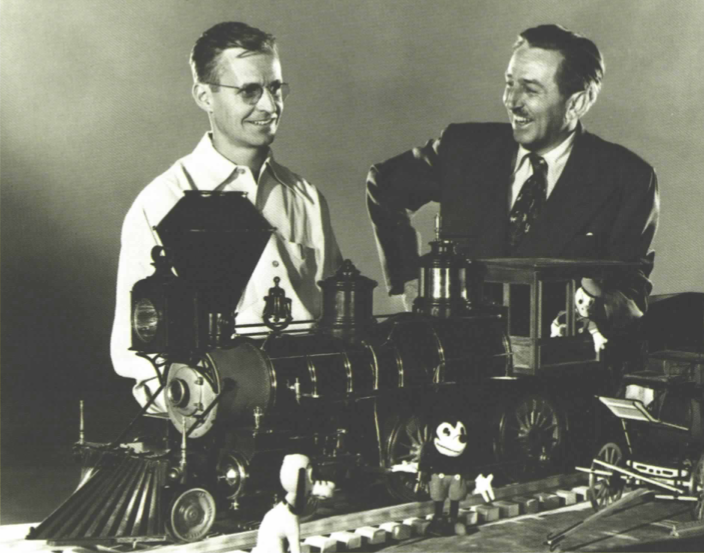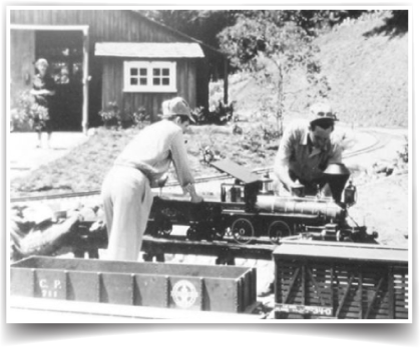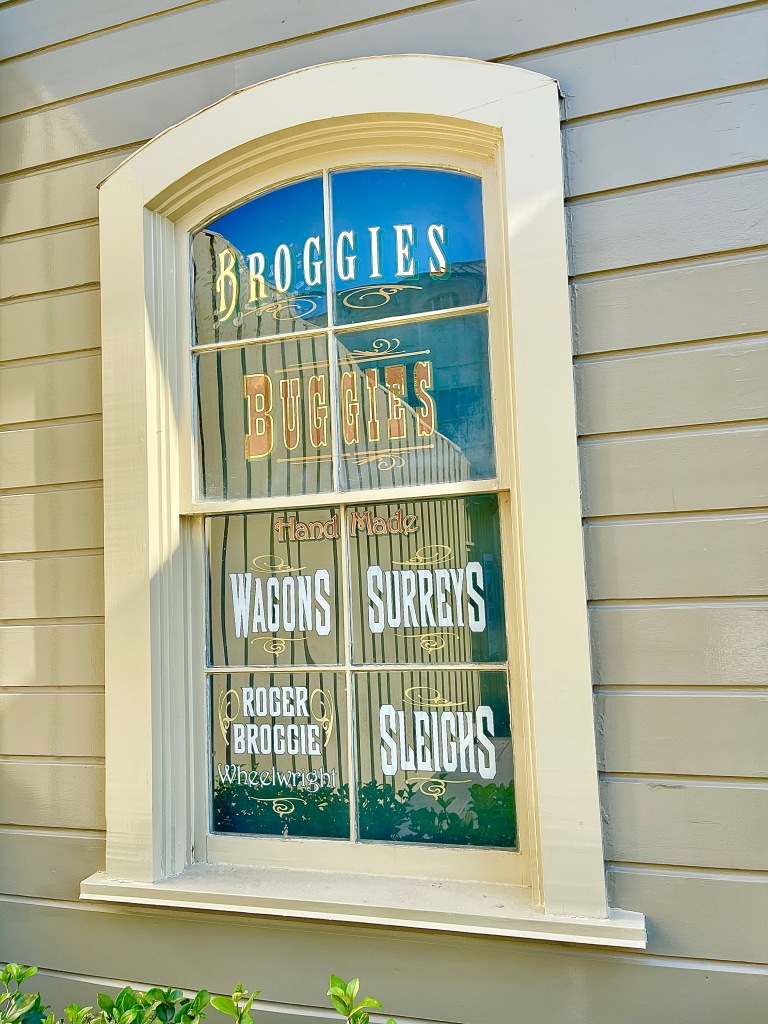Disney’s Original Imagineer
On this day in 1908, Disney’s original Imagineer, Roger Broggie, was born in Pittsfield, Massachusetts. In the early years of Disneyland, if something in the park moved, then there was a good chance Roger was somehow involved. Perhaps more importantly, Roger helped Walt Disney build a scale model railroad in his backyard and in doing so he demonstrated to Walt that he could go beyond creating fantasies on a movie screen – he could build them in real life.

After working as a machinist in Hollywood for a number of years, Roger was hired by the Disney Studios in 1939 as the new studio in Burbank was nearing completion. One of Roger’s first jobs at the newly built studio was to install the multiplane camera animation equipment. He would work with Disney Legend Ub Iwerks on a variety of camera and special effects projects. It was said that if Ub could imagine it, Roger would figure out a way to build it. A relationship that would later be replicated as Walt set out to build Disneyland.
Following a trip to the Railroad Fair in Chicago in 1948, Walt hoped to build a scale model railroad in the backyard of a new home he was building in the Holmby Hills neighborhood of LA. After Walt asked Ed Sergeant to draft plans for a locomotive based off an old Central Pacific engine, Number 173, he sought out the help of Roger in the machine shop – which at the time occupied one of the wooden “boxcars” located by the studios’ main entrance. Roger and the other machinists went to work. Early most mornings, Walt would stop by and check on the progress. Before long he told Roger, “I don’t want to interfere with what the boys are doing, but I don’t think it is fair that they’re having all the fun. I’d like to help, too.” The next day Walt walked in and saw an open workbench with a sign over it that read “Walt’s Workplace.” Walt spent as much time as he could learning how to use the various machines and tools in the shop. Roger later said, “I guess we made a pretty good apprentice machinist out of him. He surprised all of us. In many ways…he had a high aptitude for machine work.” In May of 1950, Roger oversaw the delivery of the Lilly Belle locomotive, named after Walt’s wife, from the studio to Walt’s house for its first steam-up. Roger, and his sons, would regularly join Walt at his house on weekends as they entertained guests aboard the Carolwood Pacific Railroad.

In 1951, Walt asked Roger to help on “Project Little-Man,” an early exploration of audio-animatronic technology. Roger and his team would develop a system of cables and cams enabling the small figure to dance. A couple years later, Roger worked to get something much bigger to move – the giant squid in the epic conclusion of 20,000 Leagues Under the Sea. Shortly after the shooting on that film wrapped, Walt approached him about working on Disneyland. “We need to get started building the railroad for the Park,” he said. “Do you think our boys can do it here at the studio?” “Sure,” Roger replied. “Since we did the Lilly Belle locomotive and have all the information on the trains already, we can just take the drawings and blow them up for the Park locomotives.”
A new, larger machine shop for Roger and his growing team of machinists was soon built on the studio lot. However, they still need space to store things as large as railroad passenger cars, so soundstages had to be used to the chagrin of movie producers. While the rail cars and locomotive for the Disneyland railroad were designed at 5/8 scale, at Walt’s request, Roger did successfully lobby for slightly larger 3/4 scale cabs for the train engineers to sit in.

In addition to the two locomotives and passenger cars for the Disneyland Railroad, Roger worked on a number of other park attractions. Nearly all of the Fantasyland ride vehicles were manufactured by Arrow Development. But since most were unique to Disneyland, Roger and other machinists were needed to iron out kinks with the ride systems. For the Circarama attraction, Roger once again teamed up with Ub Iwerks to develop a first-of-its-kind camera rig that was mounted on top of a car to film scenes in 360 degrees.

In the years that followed Disneyland’s opening, Roger and his team of machinists helped enhance both the reliability and capability of audio-animatronic figures throughout the park. As Walt and other Imagineers worked to improve and develop new attractions they’d bounce their ideas off Roger to see if they were technically feasible. According to Imagineer Bill Martin, “As far as audio-animatronics, the person who tells them it can’t work is Roger Broggie.” Thankfully, Roger was motivated to find ways to make things work, as he did with projects he contributed to including the Enchanted Tiki Room and Great Moments with Mr. Lincoln.

Roger was tasked in 1958 to evaluate new monorail technology developed by the Alweg Corporation in Cologne, Germany. After visiting the company along with Joe Fowler and seeing their system operate, Roger told Walt he thought it was a viable option for Disneyland. Walt wanted the monorail to open as part of what’s known as Disneyland’s second grand opening in 1959. He sent Roger and Imagineer Bob Gurr back to Cologne to make it happen. They soon realized there simply wasn’t enough time for Alweg to build the monorail trains and ship them all the way to California in time. However, after Roger and Bob explained how they had previously built Viewliner train cars, the Alweg engineers felt confident the Disney team could build the monorail cars on their own too if they provided the blueprints and consultants. In the following months, Roger, Bob and other Imagineers successfully built the first monorail system to operate in America.
When Walt Disney World was being built Roger was once again called upon to assemble a railroad. To acquire the locomotives for the Magic Kingdom, Roger set out for Mexico after learning of a number of trains that were recently put out of use. His good fortune was almost derailed by a Mexican regulation prohibiting their exportation, however Disney was able to exploit a loophole that allowed it since they were originally made in the United States.
When Roger retired in 1975, he said “Walt left me 10 years of work when he died; once it was done, I was ready to retire.” A number of tributes recognizing Roger’s extraordinary contributions to the Disney Parks can be found. In Walt Disney World’s Magic Kingdom the No. 3 railroad locomotive is fittingly named Roger E. Broggie and there is a window on the Main Street street car barn named “Broggie Buggies.

In Disneyland, there’s a window on Main Street above the magic shop dedicated to Roger that reads:
Can Do Machine Works
Mechanical Wonders – Live Steam Engines – Magical Illusions – Cameras
Roger Broggie
Shopmaster
Advisor to the Magic Makers

If you are interested in reading more about Roger Broggie and the history of Disney railroads, I highly recommend Walt Disney’s Railroad Story, a book written by Roger’s son Michael Broggie. The book is out of print, but second hand copies are available though a bit pricey. You can also buy a digital PDF copy of the book here from The Carolwood Society.
On This Day People Bill Martin Joe Fowler Roger Broggie Ub Iwerks Walt Disney
